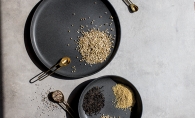
Stepping into the new year in Minnesota can be a struggle. The days are cold, wet and dark, and the holidays that once brought light and community are gone. In these seemingly endless weeks, it’s common for one’s mental and physical health to falter. So, if you’re craving a solution to the winter blues, you’re not alone.
We turned to Amber Hanson of Whole You Nutrition, a licensed nutritionist and certified nutrition specialist practitioner and intuitive eating counselor, to learn more about how we can shift our New Year’s resolutions from harmful dieting to improving our overall relationship with food.
With a passion for helping clients find peace with food to support health and happiness, Hanson says rather than thinking about food in terms of calories or macronutrients, it’s important to consider the role food plays in a person’s total health, including mental health. Things like texture and flavor can be just as impactful for mental health as the properties and nutrients of an ingredient are for physical health.
“Food brings pleasure and comfort, and if we’re really restricting certain things, we’re missing out on those mental health benefits of seeing food in its full capacity,” Hanson says. “Warming and comfort food doesn’t have to be bad for you.”
Boost the Mood
While each person is different, and comes from a variety of health histories, Hanson often starts clients off with education on functional nutrition. Functional nutrition is not a one-size-fits-all discipline. It helps make the connection between what you eat and how you feel. It works to address the root cause of a situation rather than only treating symptoms.
So, what are the ideal nutrients the human body needs to boost one’s mood during the winter months? What ingredients should we incorporate into our diets for a healthier body and mind? Here are some of Hanson’s favorite options to level up your winter meal prep:
Vitamin D: May decrease incidence of depression and seasonal affective disorder (SAD) cod liver oil, egg yolks, salmon, sardines, tuna, liver, fortified cereals, fortified milk, orange juice
Magnesium: May reduce symptoms of major depressive disorders and common mood swings leafy greens, legumes, nuts, seeds, dark chocolate
Omega-3 fatty acids: May decrease the symptoms of both anxiety and depression salmon, mackerel, sardines, herring
Tryptophan: May reduce fatigue, increase positive emotion and enhance sleep quality meats, eggs, cottage cheese
Vitamin C: May lower anxiety and stress by reducing cortisol, a stress hormone citrus fruits, bell peppers, strawberries, broccoli
Fermented foods: Shown to improve digestive health and provide natural sources of probiotics, eliminating the need to use supplements sauerkraut, kimchi, yogurt, kombucha
B Vitamins: Low levels can create a mix of anxiety and lethargy
B12: Meat, fish, eggs, nutritional yeast
B6: Salmon, meat and poultry, sweet potatoes
Folate: Leafy greens, legumes
Listening to your body
While it’s important to fuel the body with healthful foods, Hanson warns of the harmful impact restriction can have.
“The way the human mind reacts to restriction is wanting the thing it can’t have,” she says. “This often leads to white knuckling through several weeks of not having whatever that thing is ... Then losing it and going through a binge cycle
of having that thing.”
Restriction can also impact social gatherings. Hanson says people tend to avoid situations where it might be more challenging to resist the foods they’ve put restrictions on.
“During [winter months] when [SAD] can be at the highest for people, they might avoid social interactions with people,” she says, noting that socializing is important for mental health. “It feels too hard to meet up with friends if you’re restricting certain foods.”
It’s important for people to work with their bodies to make sure they’re getting a variety of food on a regular basis, especially from a mental aspect.
“That restrictive or detailed diet plan is exhausting,” Hanson says. “My approach to the work is more getting to the point that your body will tell you what it needs versus me telling you what you should be doing.”
Instant Pot Turmeric Coconut Chicken Thighs
Courtesy of Amber Hanson
The Instant Pot can make quick work of cooking up a batch of flavorful protein. For chicken, I like using thighs as they tend to be a little more juicy than super lean breast meat. This recipe is full of warm spices and creamy flavor, perfect for cooler weather. Serve it up on cauliflower rice, and garnish with a sprinkle of green onions and chopped cilantro for a bit of freshness.

Makes 6 servings
Prep time: 10 minutes
Total time: 45 minutes
- 2 lbs. boneless, skinless chicken thighs
- 1 1/2 tsp. salt
- 1 tsp. ground black pepper
- 1 Tbsp. coconut oil
- 1 Tbsp ground turmeric
- 2 tsp. garam masala
- 1 tsp. ground ginger
- 1 tsp. garlic powder
- 1 tsp. fennel seeds
- 1/4 tsp. cayenne pepper
- 1 (13.66-oz.) can coconut milk
- cauliflower rice, to serve
- green onion and fresh cilantro, to garnish if desired
Season chicken thighs with salt and pepper; set aside. Select the sauté function from the Instant Pot control panel. Add coconut oil to insert; melt. Add spices; cook for 30–60 seconds until fragrant. Whisk in coconut milk and bring to a simmer. Add chicken; coat completely in coconut milk mixture. Twist Instant Pot lid on and switch valve to sealing. Select manual pressure and set for 10 minutes. Allow pressure to release naturally for 10 minutes before carefully quick releasing any remaining pressure. Remove chicken and shred with 2 forks. Sauce can be reduced using sauté function if desired. Return chicken to the sauce. Serve over cauliflower rice and garnish with chopped green onion and fresh cilantro, if desired, stir to coat evenly. Let cool completely before storing.
Crunchy Chickpeas
Crunchy chickpeas are a delightful snack. I also like to use them instead of croutons in a salad or as a topper for soup. I have included savory garlic and smoked paprika seasoning in this recipe but the flavor is really only limited by your imagination or spice cabinet. Store them in a tightly sealed container at room temperature for up to a week.
Makes: 3-4 servings
Prep time: 5 mins
Total time: 50 mins
- 1 (15-16-oz.) can chickpeas or garbanzo beans, drained and rinsed
- 2 tablespoons avocado oil
- 1/4 teaspoon sea salt
- 1/4 teaspoon garlic powder
- 1/4 teaspoon smoked paprika
Heat oven to 400 degrees F. Pat rinsed chickpeas dry with a kitchen towel. Remove any skins that have loosened (you don't need to peel them all!). Place on a rimmed baking sheet and coat with oil. It may seem like a lot of oil but this is what helps them get crunchy in the oven. Bake for 40-45 minutes. Test a bean or two to make sure they are crunchy. If they still have a leathery texture keep baking them until dry and crunchy. Sprinkle with spices and shake pan or stir to coat evenly. Let cool completely before storing.
Tip: If you double or triple the recipe you may need additional baking time.
About Amber Hanson
Prior to entering the nutrition field, Hanson worked as a chef, food product developer, recipe developer and food stylist. Her passion for cooking carries over to her work as a nutritionist where she develops new recipes. Hanson’s education includes a master’s degree in applied clinical nutrition from Northeast College of Health Sciences in upstate New York, a bachelor’s degree in food science and nutrition dietetics from the University of Minnesota - Twin Cities and an associate degree in applied science in culinary arts from The Art Institutes International Minnesota. She started Whole You Nutrition in 2018.

A day of mood-boosting meals
Breakfast: Egg bake with broccoli, turkey sausage and sweet potato with avocado
Lunch: Grilled salmon over leafy greens with dried cherries, toasted walnuts dressed with olive oil and balsamic vinegar, kombucha
Dinner: Turmeric coconut chicken over a blend of chickpeas and cauliflower rice
Find more recipes, subscribe to Hanson’s monthly newsletter and get in touch with her at wholeyounutrition.com.









